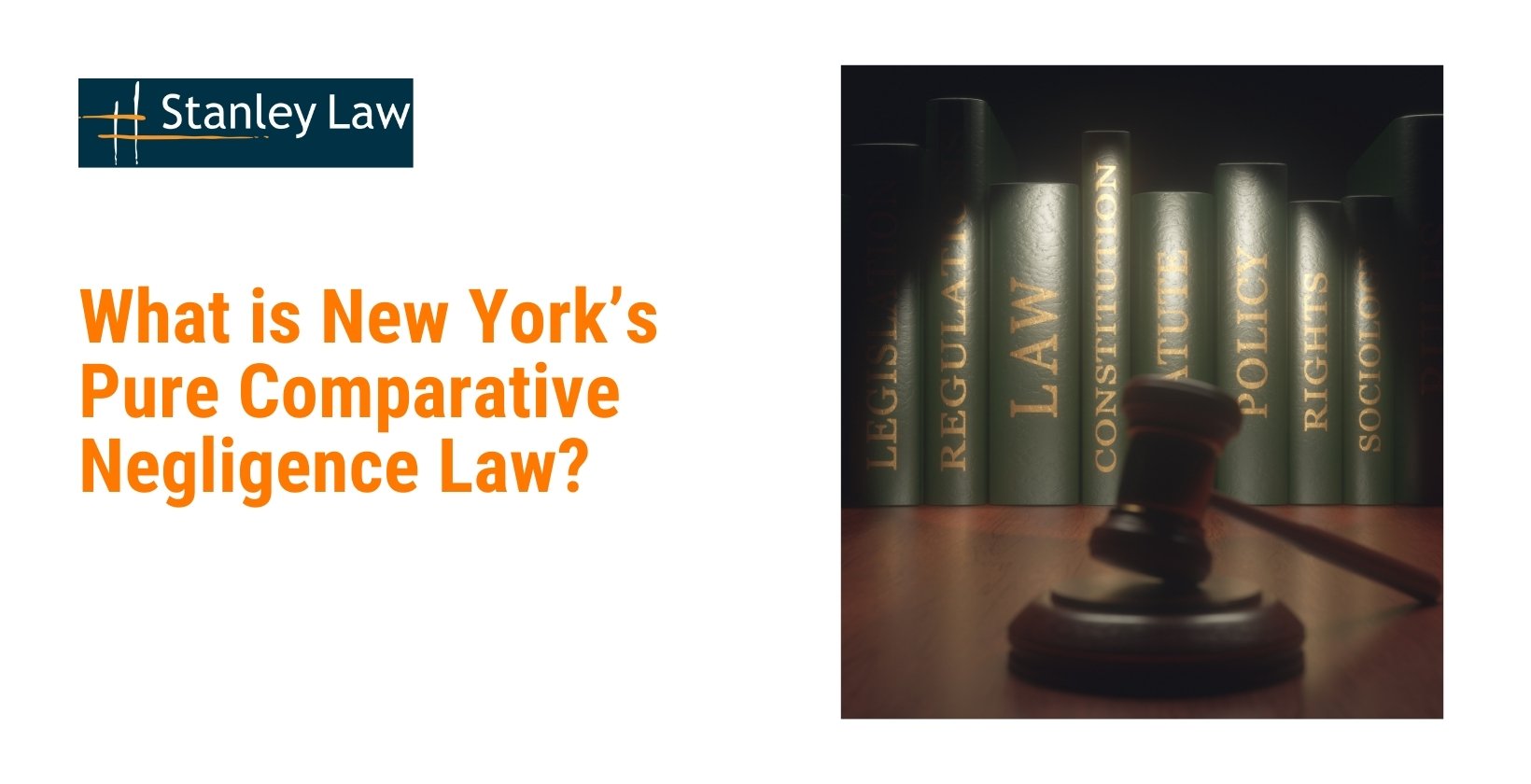New York’s pure comparative negligence law allows an injured person to recover compensation even if they are found mostly at fault for an accident, up to 99%. Instead of barring recovery, this law reduces the final compensation award based on the percentage of fault assigned to that person.
For example, if a person is found 80% at fault in a car accident and their total damages are $50,000, they could still recover 20% of that amount, $10,000, under New York’s pure comparative negligence law.
If you’ve been involved in an accident and someone has suggested you’re partly to blame, that does not automatically disqualify your claim. Understanding how fault is calculated under New York law is essential to protecting your right to compensation.
How Does Pure Comparative Negligence Work in New York?
New York injury claims involve assigning fault to each party and adjusting compensation based on those percentages. Insurers and courts evaluate the actions of everyone involved to determine liability. This process applies in car accidents, slip-and-falls, construction injuries, and other personal injury cases.
Fault percentages allocated to each party
Under New York Civil Practice Law and Rules (CPLR) § 1411, fault in a personal injury case is divided based on how much each party’s actions contributed to the accident. This is a legal process used by insurance companies, judges, or juries to assign percentages of responsibility.
For example, in a Bigmahton car crash where one driver runs a stop sign and the other is speeding, the court might assign 60% fault to one and 40% to the other. Each party’s ability to recover compensation depends on these percentages.
This approach reflects New York’s focus on proportional accountability. No one is completely barred from recovering damages – even if they share most of the blame.
Damage awards reduced according to fault share
Once the fault is determined, New York law requires that any awarded damages be reduced based on the injured party’s percentage of responsibility.
Example: If your damages are valued at $50,000 and you’re found 30% at fault, your compensation would be:
$50,000 × (1 – 0.30) = $35,000
Even if you share blame for the accident, you’re still legally entitled to recover the portion of damages that reflects the other party’s fault. This structure ensures accountability without punishing honest mistakes.
Shared liability among multiple parties
In serious accidents involving multiple parties, joint and several liability applies. This means any one responsible party can be held fully liable, even if others also contributed to the accident.
Example: A pedestrian is hit during a three-way crash. The court finds:
- Driver A: 50% at fault (ran red light)
- Driver B: 30% at fault (texting and swerving)
- Pedestrian: 20% at fault (jaywalking)
The pedestrian’s compensation would be reduced by 20%, but they could still recover the remaining 80% from either driver. The at-fault drivers would then resolve reimbursement between themselves. This rule protects injury victims from being left uncompensated due to disputes between negligent parties.
Evidence types used to determine negligence
To determine who is at fault, courts and insurers rely on several types of evidence:
- Police reports: Offer official records of citations, officer observations, and accident scene details.
- Medical records: Help link injuries to the incident based on timing and severity.
- Surveillance or dashcam footage: Can capture critical moments before or during the accident.
- Eyewitness statements: Offer third-party insight into driver behavior or road and weather conditions.
- Expert testimony: Accident reconstruction specialists can analyze impact angles, speed, and damage patterns.
Gathering and preserving this evidence early often plays a major role in strengthening your case and preventing insurers from downplaying your right to recover.
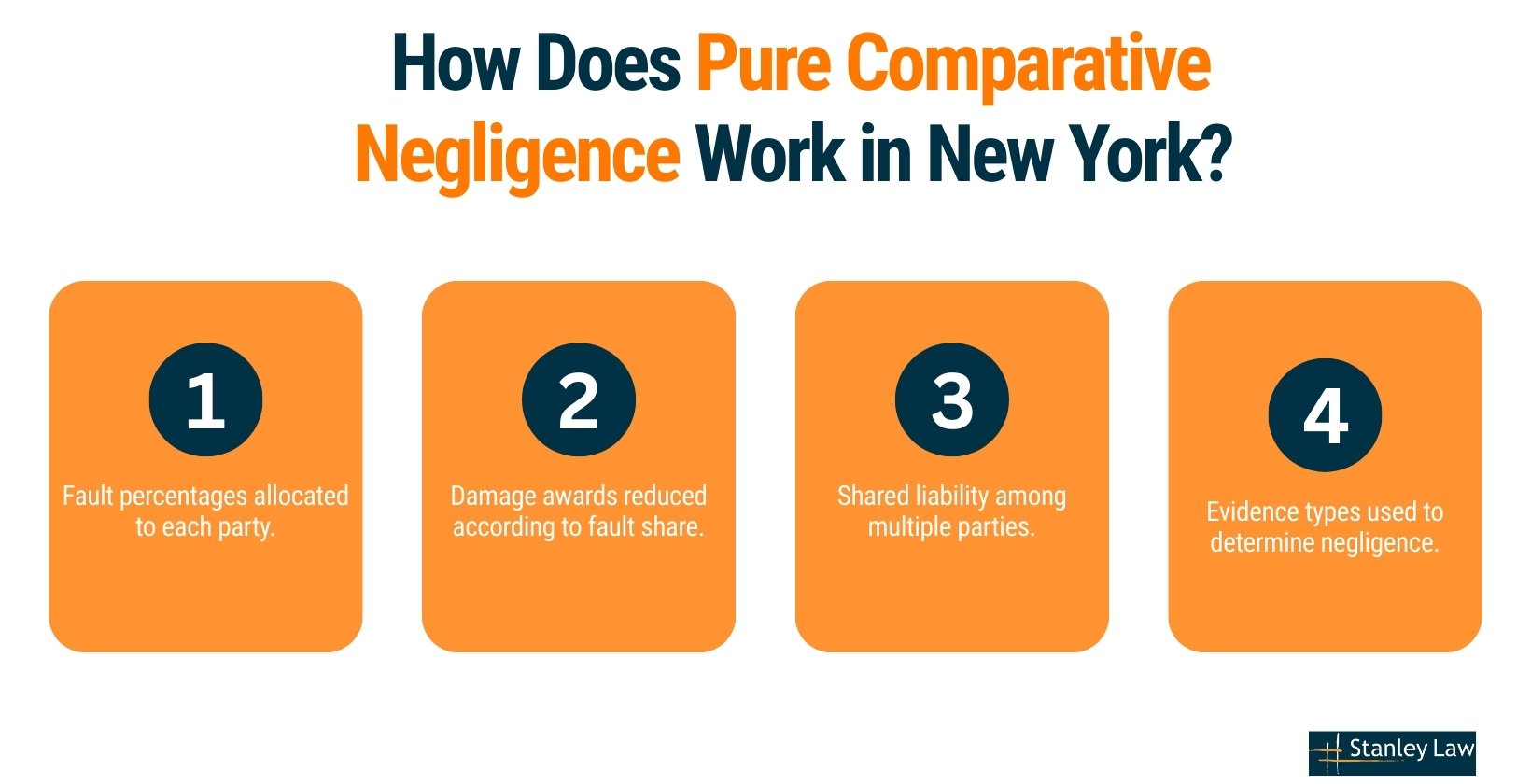
What Makes New York’s Law Different From Other Negligence Systems?
Every state handles fault differently in personal injury claims. While New York follows a pure comparative negligence model, most other states use modified comparative negligence, and a few still follow the strict contributory negligence rule. These differences matter. In many states, being even slightly at fault can block you from recovering anything.
Pure vs. modified comparative negligence
In modified comparative negligence states, there’s a cutoff – if you’re found 50% or 51% at fault, you get nothing. It doesn’t matter how serious your injuries are; crossing that threshold bars your recovery completely.
New York doesn’t use this rule; your recovery is reduced, not denied.
| Model Type | Can You Recover at 51% Fault? | State Using This Rule |
|---|---|---|
| Pure Comparative (NY) | Yes | New York, California, Florida, Louisiana |
| Modified Comparative (50% bar) | No | Texas, Colorado, Illinois, Michigan |
| Modified Comparative (51% bar) | No | Georgia, Arkansas, Maine, South Carolina |
| Contributory Negligence (1% bar) | No | Alabama, Maryland, North Carolina, Virginia |
Let’s say you’re in a bicycle accident and suffer $100,000 in damages.
In New York (pure):
You’re 60% at fault → You recover $40,000
In Texas (51% bar):
You’re 60% at fault → You recover $0
Pure comparative vs. contributory negligence
Contributory negligence is the strictest model still in use. It bars injured people from recovering any compensation if they are even 1% at fault. Only a few states follow this system, but the impact on your case can be devastating.
| Scenario | In New York (Pure) | In Contributory States |
|---|---|---|
| 5% at fault in a bicycle accident | Recover 95% | Recover nothing |
| 20% at fault in a slip-and-fall | Recover 80% | Recover nothing |
Who Decides Fault Percentage in a New York Injury Claim?
Fault is first evaluated by insurance companies, but if the parties disagree, the decision ultimately rests with a judge or jury. Insurers conduct initial investigations and assign fault based on police reports, statements, and evidence. If the case goes to court, each side presents its case, and the court decides how fault is divided.
Role of the jury in fault allocation
If your case reaches trial, the jury or judge in a bench trial determines how much blame each party shares. They review all the evidence and assign a percentage of fault to each side based on what the law calls comparative negligence.
- Jurors follow legal instructions from the judge and weigh:
- Witness credibility and consistency
- Expert testimony, like accident reconstruction reports
- Physical and documentary evidence
- Compliance with traffic or safety laws
- How each party’s actions contributed to the outcome
Their decision directly affects how much compensation each party receives or pays.
Evidence presentation and legal strategy
Both sides use strategy and evidence to argue for a lower share of responsibility. The plaintiff has the burden of proof, meaning they must show how the defendant’s actions caused the accident.
Attorneys rely on:
- Dashcam footage or surveillance video
- Eyewitness statements
- Police reports
- Medical records
- Expert analysis of crash scenes or safety conditions
Example: One party may show footage of a driver running a red light. The defense might argue the injured person was speeding or distracted. The jury weighs both to assign fault percentages.
If you’re being blamed even partly, clear, early evidence can protect your ability to recover damages.
Can You Recover Damages If You’re 99% At Fault in New York?
Yes. New York law allows partial compensation even if you were almost entirely at fault.
If you’re found 99% responsible, you’re still legally entitled to recover 1% of your total damages from the other party.
For example, with $100,000 in damages, you could still receive $1,000. This reflects the exact portion of fault that the other party carries, no more, no less. However, the closer your share of fault approaches 100%, the more likely insurers are to challenge your right to recover any damages.
How Is Compensation Calculated Under Pure Comparative Negligence?
In New York, compensation is adjusted based on your share of fault. The more you’re responsible for the accident, the less you can recover, but recovery is never completely barred. The exact amount depends on how fault is assigned and whether you’re dealing with insurers or the court system.
Damage formula based on fault percentage
New York uses a straightforward calculation:
Total damages × (1 – fault percentage) = Your recovery
If your case is worth $75,000 and you’re 40% at fault, your recovery would be:
$75,000 × (1 – 0.40) = $45,000
Even at high fault levels, the law ensures a proportional recovery, which makes New York more claimant-friendly than states with strict fault cutoffs.
Insurance-adjusted payout methods
Insurers often apply their own formulas when offering settlements, and these don’t always reflect what you’re actually owed under the law. Adjusters may:
- Reference police reports or witness statements.
- Use software like Colossus or similar tools to generate ranges.
- Apply conservative estimates of damages based on perceived fault.
Caution: An insurance estimate is just a starting point, not the final word. If the fault is disputed or the offer seems low, getting legal guidance can help you challenge it and pursue the full amount you’re entitled to.
Which Types of Accidents Commonly Involve Comparative Negligence in New York?
Comparative negligence often applies in cases where more than one person or company contributed to an accident. These situations are more common than many people realize and play a central role in determining how liability is divided and compensation is calculated.
Shared fault in New York car accidents
Car accidents frequently involve split liability. It’s rare for only one driver to be 100% responsible. Illustrative scenarios:
- One driver runs a stop sign; the other is speeding.
- A car turns illegally while the other driver is distracted.
- One driver fails to signal; the other fails to yield.
- Tailgating followed by a sudden brake from the lead car.
Evidence like dashcam video, traffic citations, and eyewitness statements often determines how much fault each driver carries.
Liability distribution in slip-and-fall cases
In premises liability cases, both the property owner and the injured person may have contributed to the incident. Contributing factors may include:
- Negligent maintenance, like uncleared spills.
- Distraction, such as walking while texting.
- Lack of warnings, like missing signs or poor lighting.
- Unsafe footwear that increased slip risk.
Comparative negligence affects how much the injured person can recover, even if the property owner was clearly negligent.
Workplace accidents with multiple negligent parties
Construction and industrial accidents often involve shared liability across contractors, subcontractors, and even the injured worker.
Example: A worker is injured in a scaffold collapse. Investigation shows:
- The general contractor skipped safety inspections
- A subcontractor removed safety pins
- The worker failed to secure their harness
Each party could be assigned a percentage of fault – including the worker. Compensation is then divided based on those fault percentages across insurers and legal claims.
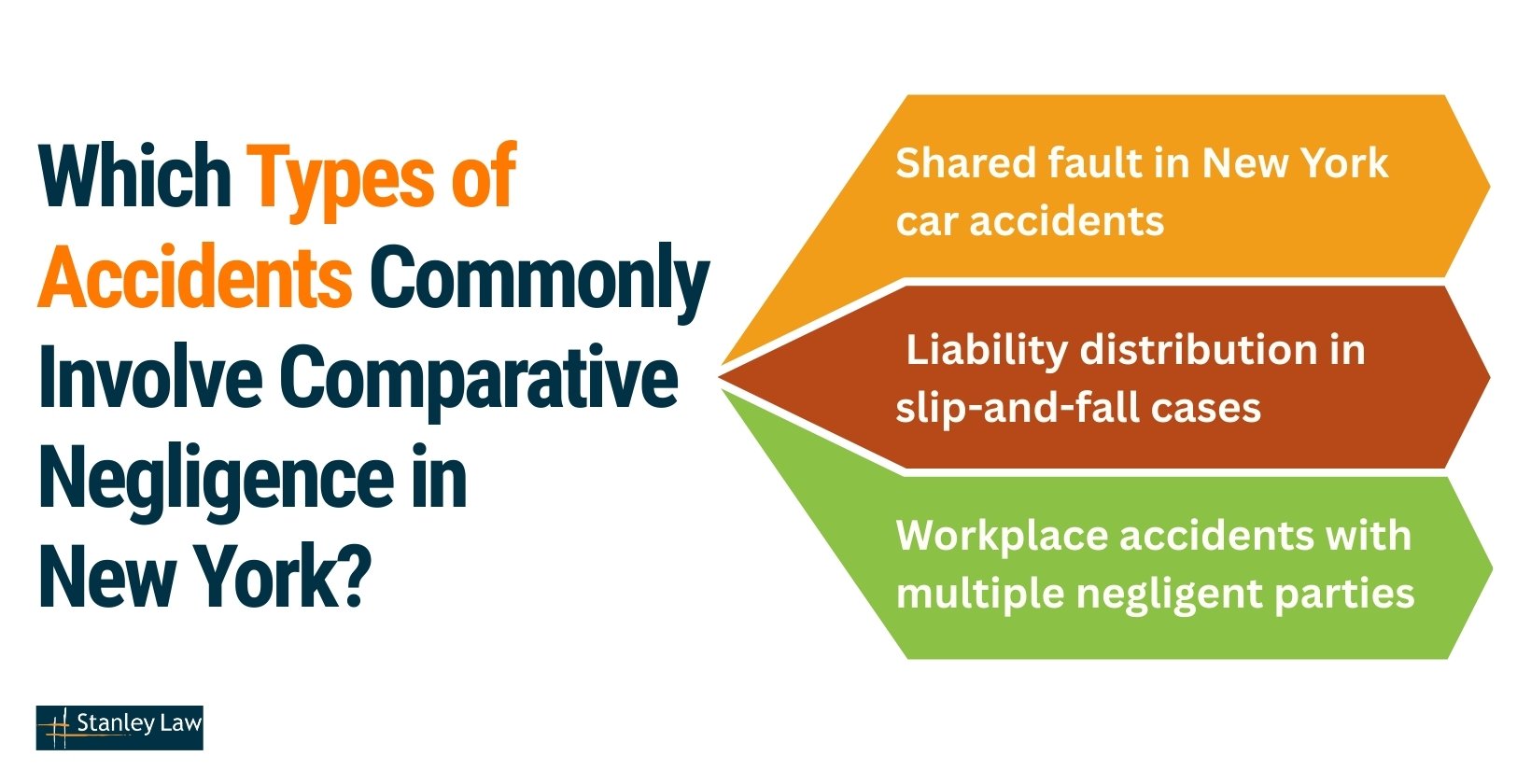
How Do Insurance Companies Use Comparative Negligence in New York?
Insurance companies use New York’s comparative negligence laws to justify reducing settlement offers. The more fault they can assign to you, the less they have to pay, even if their policyholder was primarily responsible.
To do this, insurers rely on internal evaluation tools, adjuster strategies, and selective use of early evidence. While the law permits recovery even at 99% fault, insurers often interpret and apply that law in ways that benefit them, not you.
Fault-shifting tactics used by insurers
Adjusters are trained to look for any evidence of contributory behavior to minimize their client’s liability. Even small actions can be used to justify a lower payout.
Common tactics include:
- Citing partial negligence, like being distracted during a fall.
- Downplaying their policyholders’ role in multi-vehicle accidents.
- Relying on incomplete or preliminary police reports.
- Requesting early recorded statements before the medical evidence is in.
- Emphasizing “avoidable” conduct, such as not wearing seat belts or proper footwear.
- Misinterpreting shared fault in construction or pedestrian incidents.
These strategies aren’t illegal, but they can seriously reduce what you’re offered.
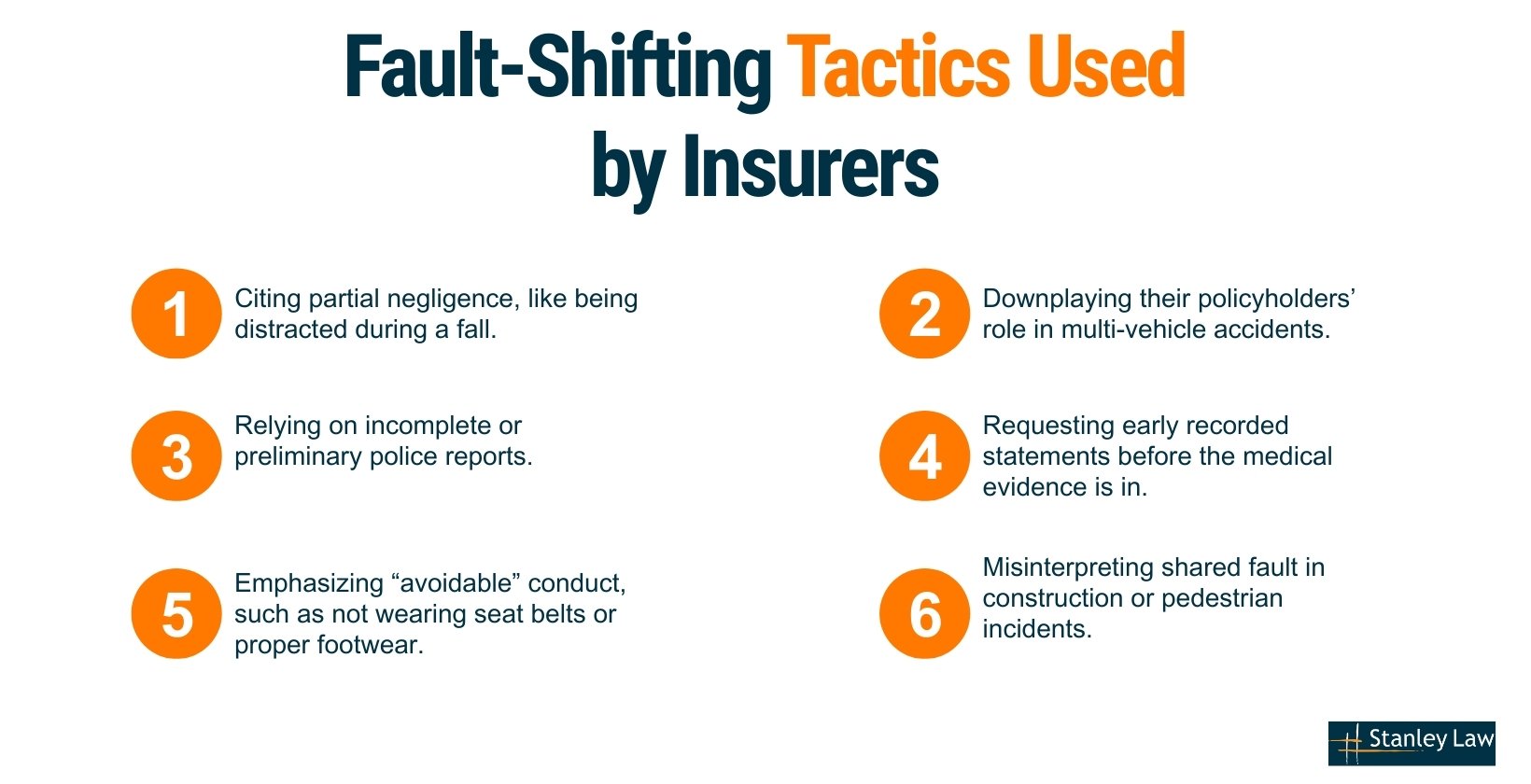
Claim reduction strategies based on shared fault
Insurers often assign fault percentages that favor their own bottom line. These calculations are based on internal tools and judgment calls, not legal standards, and often result in settlement offers far lower than what a court might award.
Remember: These numbers are negotiable. Insurers expect pushback, and many initial offers are lower than what courts would award.
The right legal strategy protects your settlement and maximizes your after-tax recovery.
What to Do If You’re Partly at Fault for an Injury in New York?
Being told you share fault for an accident can make you second-guess your case. But in New York, partial responsibility doesn’t eliminate your right to compensation. What matters most is how well you document and respond to the claim from the start.
Here’s how to protect your legal position early in the process:
Secure Evidence Before It Disappears
- Take photos or video of the scene and any injuries.
- Get names and contact details for witnesses.
- Request surveillance footage, if available.
- Preserve damaged equipment or objects involved in the incident.
Document Everything in Real Time
- Write down how the injury happened while it’s fresh.
- Save all communication with insurers or adjusters.
- Keep receipts and records of any out-of-pocket expenses.
Get and Keep Medical Record
- Seek medical attention right away, even for minor injuries.
- Follow your doctor’s treatment plan.
- Request detailed reports showing the diagnosis and injury cause.
Evaluate Fault and Legal Strategy Early
- Disagree with the fault percentage assigned by the insurer?
- Unsure how shared liability affects your payout?
- Multiple parties involved in your accident?
Don’t let partial fault silence your claim. With the right steps early on, you can still protect your right to compensation, no matter what the insurance company says.
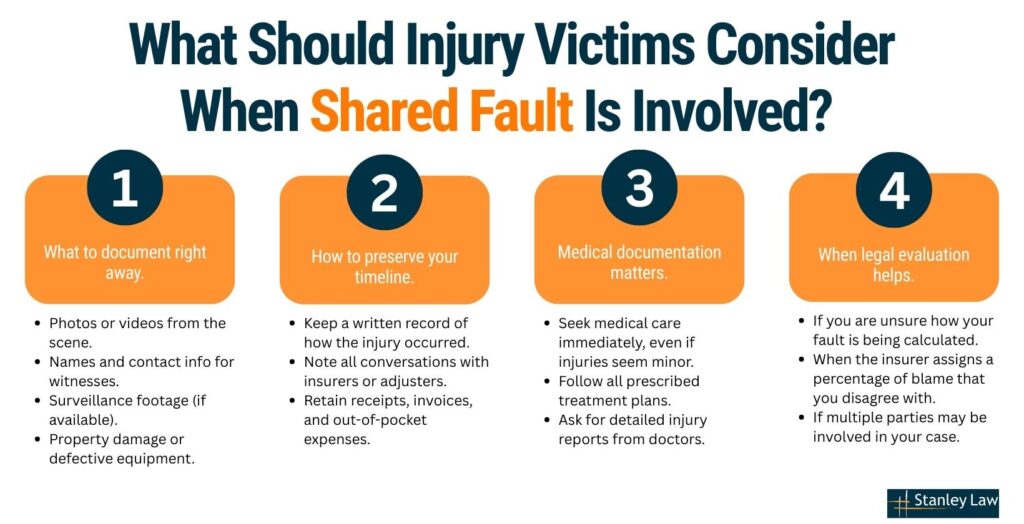
What Is the Statute of Limitations for Comparative Negligence Claims in New York?
In New York, you generally have three years from the date of an accident to file a personal injury lawsuit, even if you were partly at fault. This deadline applies under CPLR § 214, and it doesn’t change based on how much responsibility you share.
But several exceptions can shorten or extend that filing window:
Standard deadline:
- 3 years from the date of the injury.
- Applies to most personal injury claims involving shared or disputed fault
Claims involving minors:
- The statute of limitations is paused until the child turns 18.
- The full 3-year period begins on the child’s 18th birthday.
Claims against government entities:
- A Notice of Claim must be filed within 90 days of the incident.
- A lawsuit must be filed within 1 year and 90 days of the event.
- Applies to city, county, or state entities (e.g., NYC, school districts, MTA).
Claims involving mental incapacity:
- If the injured person is legally incapacitated, the deadline may be paused.
- Once they’re deemed competent, the countdown resumes.
Why Filing Early Matters:
Deadlines are strict, and missing one can end your case, even if it’s valid. The sooner you act, the more time you’ll have to collect evidence, verify fault, and assert your rights, especially when liability is contested.
Can Minors Be Held Comparatively Negligent in New York?
Yes, but with limitations. In New York, children can be held partially responsible for causing an accident, but the law doesn’t hold them to the same standard as adults. Instead, judges and juries consider what a reasonable child of that age would have understood or done in the same situation.
Age-based negligence standards for minors
New York courts assign responsibility based on age and developmental maturity. The goal is to make sure fault is only assigned when it’s fair.
Children under 4 years old: Presumed incapable of negligence.
- Ages 4 to 7: Rarely found negligent, very limited personal responsibility.
- Ages 7 to 14: May be found negligent depending on maturity, awareness, and circumstances.
- Ages 14 to 17: Held to a higher standard, especially when engaged in adult-like activities (e.g., driving, working, riding bikes on public roads).
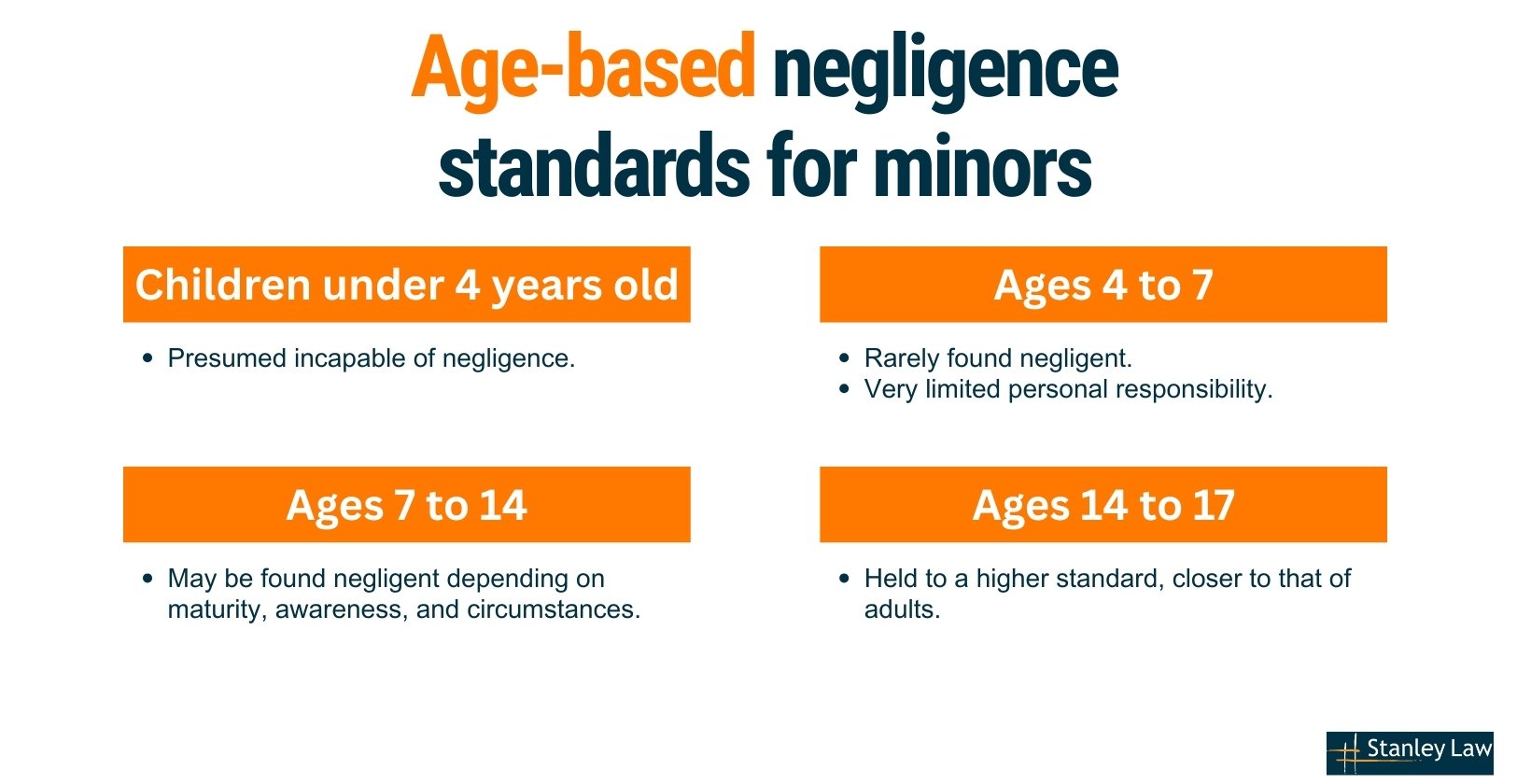
Typical scenarios where minors share legal fault
Minors may be assigned a share of fault when their actions contribute to an accident. Courts look at intent, maturity, and whether the risk should have been foreseeable for a child of that age. Examples include:
- A 10-year-old darting into traffic between parked cars.
- A 15-year-old riding a bike through a red light.
- A 13-year-old is running in a store with wet floors despite the warning signs.
- A 16-year-old is trespassing on a construction site.
- A 14-year-old distracting a peer operating machinery
In each case, the legal question is the same: Was the child’s behavior unreasonable for their age and situation?
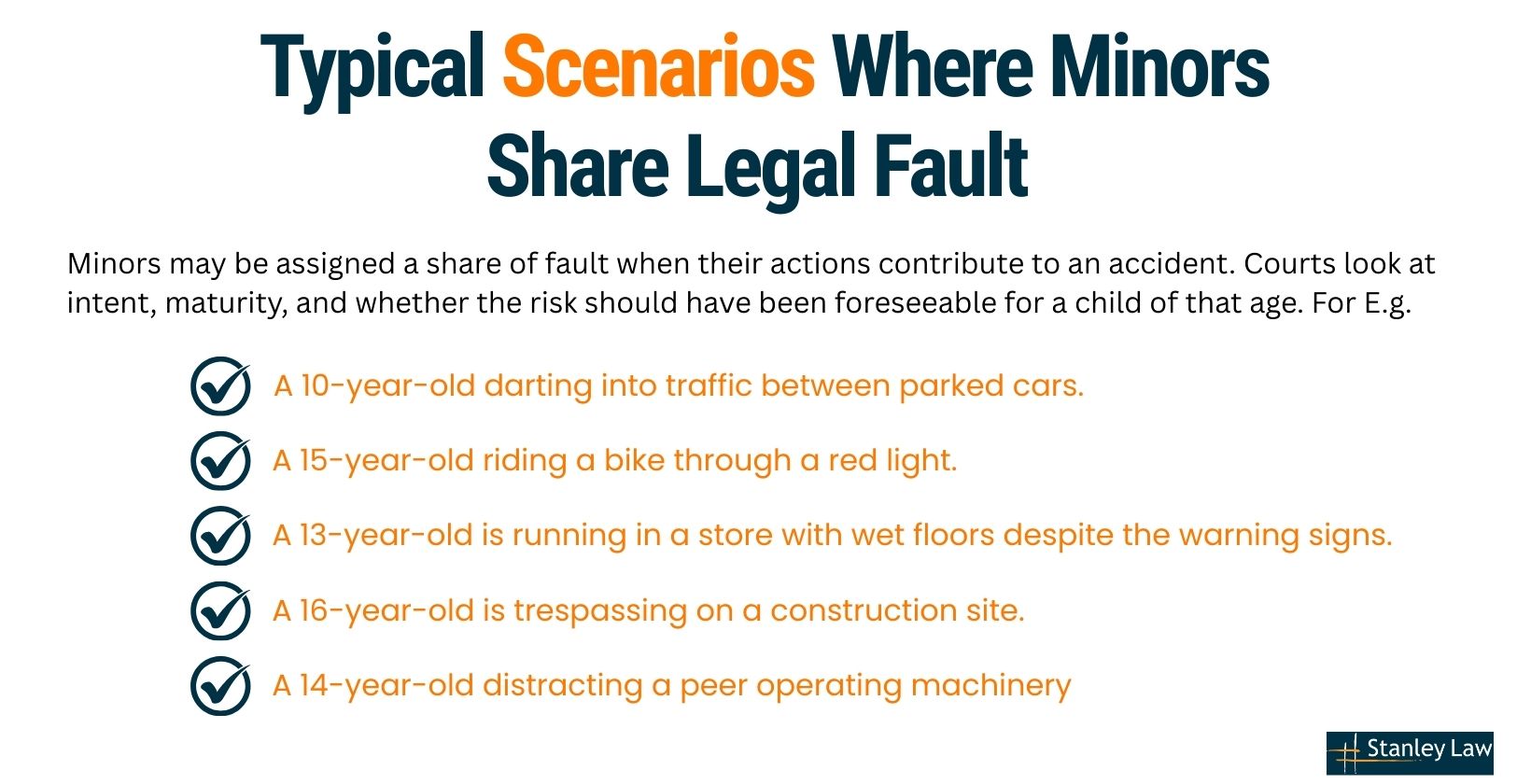
FAQs About Pure Comparative Negligence in New York
Does comparative negligence law apply to pedestrians and cyclists, too?
Yes. The law covers all injury victims, including pedestrians and cyclists. Even if you crossed outside a crosswalk or rode through a red light, you may still recover damages. Your recovery is simply reduced by your share of fault.
Does New York’s comparative negligence law apply in no-fault insurance cases?
New York’s no-fault insurance system covers medical expenses and lost wages after car accidents, regardless of fault. Comparative negligence comes into play only if you sue for pain and suffering or serious injuries. The two systems operate separately.
Does video evidence influence fault determination in New York?
Yes. Security footage, dashcam video, or even cell phone recordings can play a decisive role in fault determinations. Unlike witness memories, video provides objective proof that insurers, judges, and juries rely on when assigning fault percentages.
Can I recover damages if multiple parties were involved in the accident?
Yes. In New York, liability can be split among multiple defendants – drivers, contractors, or property owners. Each is assigned a percentage of fault, and your recovery reflects those divisions. In some cases, you may collect the full amount from one party under joint and several liability, and they handle reimbursement later.
How does comparative negligence affect settlements versus trials?
In settlements, insurers often use fault percentages to reduce offers, based on their own evaluations. In trials, judges or juries decide fault using evidence and testimony. Many claims settle first, but understanding trial outcomes strengthens your leverage in negotiations.
Key Takeaways About New York’s Comparative Negligence System
- Compensation is never barred. Even if you’re 99% at fault, you can still recover damages for the remaining 1%.
- Recovery is reduced by the fault. A 30% share of fault means a 30% reduction in compensation.
- Liability is divided fairly. Drivers, property owners, pedestrians, and contractors can each be assigned a share of responsibility.
- Children are judged by age standards. Courts only assign fault that’s reasonable for a child’s age and maturity.
- Evidence is critical. Police reports, video footage, medical records, and expert testimony shape how fault is decided.
- Deadlines still apply. Most personal injury claims must be filed within three years, with exceptions for minors and government cases.
- Insurers reduce offers using fault. Their assessments are negotiable and often lower than what the law allows.
New York’s comparative negligence law is complex, but applied correctly, it can make the difference in the outcome of a case. At Stanley Law Offices, our qualified attorneys have the experience to ensure the law works in your favor. Contact us.

